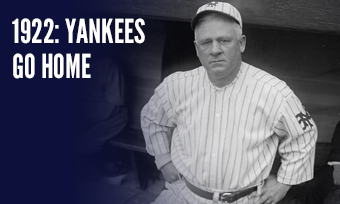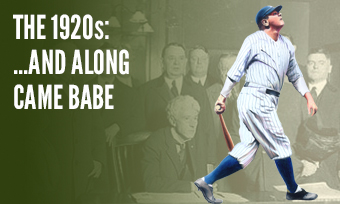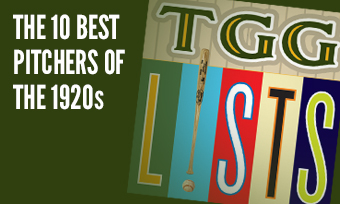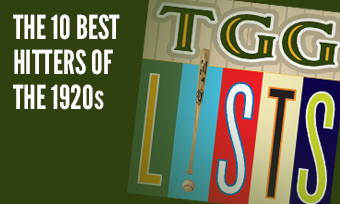The Yearly Reader
Leaders and Honors, 1922
Our list of baseball’s top 10 hitters and pitchers in both the American League and National League for the 1922 baseball season, as well as the awards and honors given to the game’s top achievers of the year.
The National League’s Top 10 Hitters, 1922
Bold type in brick red indicates league leader.
1. Rogers Hornsby, St. Louis
Key Numbers: .401 average, 141 runs, 250 hits, 46 doubles, 12 triples, 42 home runs, 152 RBIs, 17 stolen bases, .459 on-base percentage, .722 slugging percentage.
In easily his most prodigious year, Hornsby won the NL’s first triple crown since 1894.
2. Max Carey, Pittsburgh
Key Numbers: .329 average, 140 runs, 207 hits, 28 doubles, 12 triples, 10 home runs, 70 RBIs, 80 walks, 51 stolen bases, 2 caught stealing.
At age 32, the perennial stolen base leader was as potent and effective as ever; in a time when most major leaguers were happy with a 50% stolen base rate, Carey was only caught twice.
3. Ray Grimes, Chicago
Key Numbers: 138 games, .354 average, 99 runs, 180 hits, 45 doubles, 12 triples, 14 home runs, 99 RBIs, 75 walks.
Before injuries exiled him to the minors, Grimes had a terrific (and final) full major league effort which included a record 17 straight games with at least one RBI.
4. Carson Bigbee, Pittsburgh
Key Numbers: .350 average, 113 runs, 215 hits, 29 doubles, 15 triples, 99 RBIs, 24 stolen bases.
The “B” in the future “ABC Affair” that tore the Pirates apart in 1926, Bigbee peaked with personal bests in just about every offensive category.
5. Irish Meusel, New York
Key Numbers: .331 average, 100 runs, 204 hits, 28 doubles, 17 triples, 16 home runs, 132 RBIs.
The Giants remained thrilled with Meusel’s output, even if it cost them Curt Walker (below), the man they traded to get him a year earlier.
6. Zack Wheat, Brooklyn
Key Numbers: .335 average, 92 runs, 201 hits, 29 doubles, 12 triples, 16 home runs, 112 RBIs.
At 34, Wheat continued to age like fine wine thanks to the live ball; his home run and RBIs totals set career highs.
7. Curt Walker, Philadelphia
Key Numbers: .337 average, 102 runs, 196 hits, 36 doubles, 11 triples, 12 home runs, 89 RBIs.
Traded to the Phillies from the Giants a year earlier, Walker showed in his first full year that not all trades involving the Giants during the 1920s were one-sided.
8. Ross Youngs, New York
Key Numbers: .331 average, 105 runs, 185 hits, 34 doubles, 10 triples, 7 home runs, 86 RBIs.
Another routinely dynamic effort from the highly popular Giants outfielder.
9. Jake Daubert, Cincinnati
Key Numbers: 156 games, .336 average, 114 runs, 205 hits, 15 doubles, 22 triples, 12 home runs, 66 RBIs.
The former two-time batting champ, now 38 years of age, rose to the occasion to pick up the slack in Cincinnati for the departed Heinie Groh and holdout Edd Roush—all despite starting the season hitless in his first 22 at-bats.
10. Cy Williams, Philadelphia
Key Numbers: .308 average, 98 runs, 180 hits, 30 doubles, 26 home runs, 92 RBIs, 74 walks.
The “Williams Shift” was named after Ted Williams, but maybe it should have been credited to Cy, for whom defenses also stacked the right side of the infield. In both cases, it didn’t work.
The American League’s Top 10 Hitters, 1922
1. George Sisler, St. Louis
Key Numbers: .420 average, 134 runs, 246 hits, 42 doubles, 18 triples, 8 home runs, 105 RBIs, 51 stolen bases.
Only Nap Lajoie hit higher in any AL season than Sisler in 1922, though Sisler didn’t have Lajoie’s 1901 advantage of not having foul balls counted as strikes. For the third straight year, he collected four or more hits in at least 10 games; no other player has done it twice in a career.
2. Ken Williams, St. Louis
Key Numbers: .332 average, 128 runs, 194 hits, 34 doubles, 11 triples, 39 home runs, 155 RBIs, 74 walks, 37 stolen bases.
While Babe Ruth was busy racking up suspensions, Williams temporarily laid claim to the AL slugging throne—and in the process became the majors’ first 30-30 man. (There wouldn’t be another until Willie Mays in 1956.)
3. Ty Cobb, Detroit
Key Numbers: 137 games, .401 average, 99 runs, 211 hits, 42 doubles, 16 triples, 4 home runs, 99 RBIs.
At age 35, Cobb hit over .400 for the last time in his career—though it was at the center of a postseason scoring dispute over an earlier hit that would have dropped him under the mark if deleted. His four five-hit games set an MLB record that would be equaled three times, but never surpassed.
4. Tris Speaker, Cleveland
Key Numbers: 131 games, .378 average, 48 doubles, 8 triples, 11 home runs, 71 RBIs, 77 walks, .474 on-base percentage.
But of course the all-time leader in doubles would pace the AL once again, for a seventh time
5. Harry Heilmann, Detroit
Key Numbers: 118 games, .356 average, 92 runs, 162 hits, 27 doubles, 10 triples, 21 home runs, 92 RBIs.
Homers away from home: Heilmann hit 10 of his blasts at Philadelphia’s Shibe Park.
6. Babe Ruth, New York
Key Numbers: 110 games, .315 average, 94 runs, 24 doubles, 8 triples, 35 home runs, 99 RBIs, 84 walks, .672 slugging percentage.
Forty-nine home runs, 139 RBIs and 118 walks: That’s what Ruth would have totaled had he played a full season instead of being sidetracked by suspension.
7. Bobby Veach, Detroit
Key Numbers: 155 games, .327 average, 96 runs, 202 hits, 34 doubles, 13 triples, 9 home runs, 126 RBIs.
Stealing from Branch Rickey’s philosophy, Detroit player-manager Ty Cobb tried to trade Veach a year too early—to the Yankees, no less, but they declined.
8. Tillie Walker, Philadelphia
Key Numbers: .283 average, 111 runs, 31 doubles, 37 home runs, 99 RBIs.
The bringing in of Shibe Park’s left-field wall benefitted no one more than Walker, a one-time home run leader in the Deadball Era (with 11 in 1918); he’d hit only two homers the next year as age (36) and defensive deficiencies curtailed whatever future he had left.
9. Jack Tobin, St. Louis
Key Numbers: .331 average, 122 runs, 207 hits, 34 doubles, 8 triples, 13 home runs.
The Browns’ leadoff sparkplug easily racked up over 100 runs for the second straight year, but he remained lost in a spotlight hogged by teammates Ken Williams and George Sisler.
10. Bing Miller, Philadelphia
Key Numbers: .335 average, 29 doubles, 12 triples, 21 home runs, 90 RBIs.
Among the first of the star Athletics to be featured in Connie Mack’s second dynasty, Miller also engorged on the reduced left-field distance at Shibe Park, with a .370 average and 14 homers at home.
The National League’s Top 10 Pitchers, 1922
1. Eppa Rixey, Cincinnati
Key Numbers: 3.53 ERA, 25 wins, 13 losses, 38 starts, 313.1 innings, 45 walks.
Before Warren Spahn came along, Rixey would reign as the NL’s winningest lefty—and he never won more games than in 1922.
2. Pete Donohue, Cincinnati
Key Numbers: 3.12 ERA, 18 wins, 9 losses.
In his first full-time campaign, the 21-year-old Texan enjoyed the creature comforts of then-spacious Crosley Field, going 13-3 with a 2.17 ERA at the ballpark.
3. Wilbur Cooper, Pittsburgh
Key Numbers: 3.18 ERA, 23 wins, 14 losses, 27 complete games, 294.2 innings.
The Pittsburgh ace won 20-plus games for the third straight season—but also contributed on offense, hitting four of his six career homers in 1922.
4. Phil Douglas, New York
Key Numbers: 2.63 ERA, 11 wins, 4 losses.
Douglas logged just enough innings to qualify as the NL’s ERA champ before being kicked out of baseball for attempted bribery.
5. Rosy Ryan, New York
Key Numbers: 3.01 ERA, 17 wins, 46 appearances, 22 starts.
More reliever than starter, Ryan set a career high in wins and threw his only major league shutout in 1922.
6. Art Nehf, New York
Key Numbers: 3.29 ERA, 19 wins, 13 losses, 268.1 innings.
Nehf barely failed to win 20 games for the first time in three years but remained the Giants’ best option on the mound.
7. Babe Adams, Pittsburgh
Key Numbers: 3.57 ERA, 8 wins, 11 losses, 171.1 innings, 15 walks.
The veteran Pirates hurler hit the big 4-0 but continued to be effective in spite of a deceiving record.
8. Dutch Ruether, Brooklyn
Key Numbers: 3.53 ERA, 21 wins, 12 losses, 267.1 innings.
There ain’t nothing like racking them up against the weak; Ruether was a combined 12-0 against the NL’s worst two clubs, the Phillies and Braves.
9. Jeff Pfeffer, St. Louis
Key Numbers: 3.58 ERA, 19 wins, 12 losses, 261.1 innings.
After eight-plus years serving Brooklyn as a star Deadball Era pitcher, Pfeffer gave it one last hurrah as a member of the Cardinals.
10. Dolf Luque, Cincinnati
Key Numbers: 3.31 ERA, 13 wins, 23 losses, 261 innings.
Life just isn’t fair sometimes: Luque set a career-high mark in losses, though only five NL pitchers had a lower ERA.
The American League’s Top 10 Pitchers, 1922
1. Red Faber, Chicago
Key Numbers: 2.81 ERA, 21 wins, 17 losses, 38 starts, 31 complete games, 352 innings.
With his second straight AL ERA crown, Faber and his legal spitball continued to be an oasis in the wasteland that was Chicago after the Black Sox Scandal.
2. Bob Shawkey, New York
Key Numbers: 2.91 ERA, 20 wins, 12 losses, 299.2 innings.
Shawkey won exactly 20 games for the third time in four years—but fell one out shy of exactly 300 innings for what would have been the only time in his career.
3. Urban Shocker, St. Louis
Key Numbers: 2.97 ERA, 24 wins, 17 losses, 48 appearances, 38 starts, 348 innings, 149 strikeouts.
Shocker racked up workhorse figures despite missing three weeks due to injury during mid-season.
4. Herman Pillette, Detroit
Key Numbers: 2.85 ERA, 19 wins, 12 losses, 37 starts, 274.2 innings.
Detroit pitching once again stifled any attempt by a team with a prolific offense to leap towards pennant consideration, but don’t blame Pillette—who shined in a preciously short (two full seasons) career.
5. Tom Zachary, Washington
Key Numbers: 3.12 ERA, 15 wins, 10 losses.
The man who would be well known for serving up Babe Ruth’s 60th home run in 1927 never faced him in 1922; maybe that’s why he pitched so well.
6. Eddie Rommel, Philadelphia
Key Numbers: 3.28 ERA, 27 wins, 13 losses, 51 appearances, 294 innings.
Rommel led the AL in wins a year after leading it in losses, and helped the A’s out of the basement for the first time in eight years.
7. Rasty Wright, St. Louis
Key Numbers: 2.92 ERA, 9 wins, 7 losses.
Yes, there were two Rasty Wrights in major league annals; one who briefly starred in 1890—and this one, who barely qualified for the distinction of having the Browns’ best ERA by throwing exactly 154 innings (a third of an inning less and he wouldn’t have qualified).
8. Bullet Joe Bush, New York
Key Numbers: 3.31 ERA, 26 wins, 7 losses, .788 win percentage.
Thank you Boston, again; the former Red Sock celebrated his release from Harry Frazee’s purgatory by winning 20 games—and then some—for the only time in his career.
9. Elam Vangilder, St. Louis
Key Numbers: 3.42 ERA, 19 wins, 13 losses.
It’s almost amazing that Vangilder didn’t secure well over 20 wins when he was given nearly seven runs of support per start on average.
10. Walter Johnson, Washington
Key Numbers: 2.99 ERA, 15 wins, 16 losses, 41 appearances, 31 starts, 23 complete games, 280 innings, 25 grounded into double plays.
The Big Train powered out to a fast start (9-3, 2.33 ERA at the end of June) before fading late in the year. Poor offensive support—3.5 runs per start—didn’t help Johnson’s effort to avoid a rare losing mark.









